Paul Gilster's Blog, page 231
February 22, 2013
Starships of the Mind
Michael Michaud wrote the essay that follows back in 1978 for a now-defunct magazine that never published it. In recent correspondence about Daedalus designer Alan Bond, Michael referred to the essay and I asked him to forward a copy, which had also passed through the hands of Freeman Dyson and Bob Forward not long after he wrote it. Although it is dated, Starships of the Mind does a wonderful job presenting the major interstellar propulsion ideas, leavened with Michael’s innate optimism, which has inspired me for many years. It’s a bit of starship history that deserves to be in circulation, and Michael was kind enough to agree. Many thanks are owed as well to my friend David Warlick, who scanned the original and, through the wonders of optical character recognition, rendered it into digital form.
Centauri Dreams readers will know Michael Michaud as the author of Contact with Alien Civilizations: Our Hopes and Fears about Encountering Extraterrestrials (Springer, 2007), an essential book for anyone interested in SETI. Among his numerous other works are many on space exploration. Michael was a U.S. Foreign Service Officer for 32 years, serving as Counselor for Science, Technology and Environment at the U.S. embassies in Paris and Tokyo, and Director of the State Department’s Office of Advanced Technology. He has also been chairman of working groups at the International Academy of Astronautics on SETI issues.
By Michael A.G. Michaud
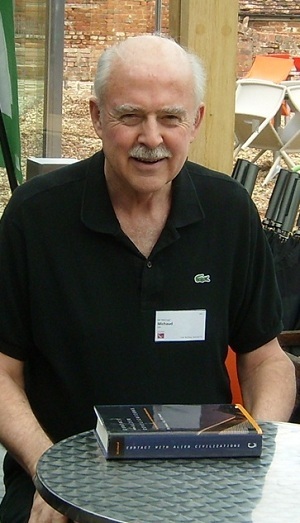
A giant is loose in the darkness of interstellar space. Its voracious maw, seventy five miles wide, sucks in particles of gas and dust, cutting a tunnel through the interstellar medium. In the monster’s interior, the miniature sun of a fusion engine converts atoms and molecules into propulsive energy, driving the giant forward, leaving a wake of superheated gas. Accelerating toward the speed of light, it races through the galaxy.
Have we tuned in on Star Trek? Not at all. This is merely a description of an interstellar ramjet, proposed by nuclear physicist Robert Bussard as one way of achieving interstellar flight.
Starflight is one of the great dreams of the 20th century. As long ago as 1918, the American rocket pioneer Robert Goddard wrote “The Ultimate Migration”, describing a journey to the stars by humans fleeing a dying Sun. During the 1930′s, science fiction writers like Olaf Stapledon began using interstellar scenarios in their stories. But, while Leslie Shepherd published a pioneering article on interstellar flight in 1952, few technical experts paid much attention.
Many scientists still argue that humans will never travel to other suns. If it is possible at all, they say, it would be so difficult, expensive, and time-consuming as to be not worth while. But others, with solid backgrounds and reputations in technical fields, are seeking ways to traverse the interstellar void. Starships are forming in their minds.
Distant Candles
The stars are the end of dream. They are the ultimate symbol of remoteness, of unknowability, of superlative achievement per ardua ad astra — through struggle to the stars. But their existence tantalizes us, suggesting infinite variety, new worlds, other lives. They are distant candles in the outer dark, luring Humankind outward from its modest origins.
The French philosopher Auguste Comte, writing in the 19th century, described the chemical nature of the stars as the ultimate example of something humans could never know. Yet in his own time astronomers were beginning to use a new tool — the spectroscope — to determine the elements in distant suns. We began to see stars as they truly are, not glowing supernatural entities beyond human ken, but measurable expressions of physical law. Measurement was the first step toward bringing them within the realm of human aspiration.
The stars are huge, yet so distant that even large telescopes show them only as points of light. In 1974, astronomers at Kitt Peak National Observatory in Arizona used a new computer-assisted technique called speckle interferometry to build up an image of Betelgeuse in the constellation Orion, a red giant star 800 times the size of our Sol. For the first time, we saw the boiling, irregular, blotched surface of another sun. The stars seemed a little closer.
But interstellar distances still stagger the human imagination. We think of our solar system as being large; the ice-dwarf Pluto, recedes to as much as 4 billion miles from the Earth in its eccentric orbit around the Sun. Only in 1978 — 48 years after its discovery — did astronomers find that Pluto has a moon. But the star system nearest to the Sun, the triple we call Alpha Centauri, is about 25 trillion miles away — 6,000 times as far as Pluto. To make the numbers manageable, astronomers measure distances to the stars in light years — the distance light travels in one year at 186,282 miles a second.
The Solar Neighborhood
Our Sun is located in the disk of the spiral galaxy we call the Milky Way, about 33,000 light years out from the center. It is on the inner edge of one of the galaxy’s spiral arms, though our view of the galactic nucleus is obscured by clouds of interstellar dust. The galaxy is enormous: about 100,000 light years across and 12,000 light years thick at the hub, containing as many as 250 billion stars.
Better to start with our own obscure neighborhood, out here in the galactic boondocks. Within 20 light years of Sol are about 90 known stars — 51 single, 15 double, and 3 triple. A few, like the bright star Sirius, are massive, hot, and short-lived. But most are cooler, reddish stars, smaller and dimmer than our Sun. A few are very similar to Sol, and may be the most likely to have planets with Earth-like conditions.
The space between the stars is not completely empty. The Sun is surrounded by planets, moons, asteroids, comets, and a disk of rarefied gas and dust. Beyond the outermost planet may lie a cloud of ice balls, marking the outer edge of the solar system; this “Oort cloud” may be the source of the comets. From that distance, billions of miles beyond Pluto, the Sun would be only a bright star. Circling in the dark, these chunks of frozen gas would be the outposts of the Sun’s empire, at the edge of the interstellar void. Other stars also might have disks of material reaching far out from them, offshore reefs around the galaxy’s islands of light.
We know that interstellar space is thinly sprinkled with atoms of gas and dust, which sometimes collect to form the clouds we call nebulas. But there also may be dark objects we have not yet found. We cannot exclude even small, dark stars, too faint for our present instruments to see.
Crossing the Gulf
We already have launched our first spacecraft to the stars: the unmanned probe Pioneer-10, which flew by Jupiter in 1973 and is now on its way out of the solar system. This spindly robot is a speedy craft by our present standards; it took only 11 hours to travel from the Earth to the distance of the Moon, and was doing over 90,000 miles an hour when it whipped by Jupiter. But its speed is so modest on interstellar scales that it would take over 100,000 years to reach the nearest star — if it were headed in that direction. Its electronic systems would die long before then, and its weak radio could not signal the Earth to tell of its discoveries. Our machines do not yet match the scale of interstellar flight. [Editor’s note: The Voyager probes had just been launched when this article was written. Pioneer 10 is now moving at 12.51 kilometers per second. The faster Voyager 1, moving at 17.1 kilometers per second, would make the Alpha Centauri crossing in about 75,000 years].
Thinking about interstellar travel by human beings brings us face to face with a more fundamental limitation: the human lifespan. No adult could count on surviving a trip of`more than about 50 years. Even at the speed of light, this would limit us to a tiny sampling of the Galaxy, and confine us to our neighborhood. Human longevity might even prevent a commitment to an unmanned probe mission lasting longer than 50 years; those who launched it would not live to hear the results. The fundamental problem of interstellar flight, then, is not distance, but time, and our attitude toward it.
The obvious, superficial solution to the time problem is high velocity, shortening the duration of the journey. But there are limits. Scientists believe that nothing can exceed the speed of light — a barrier that looks far more absolute than the speed of sound did before we broke it. And the problem is more subtle. As an object accelerates to a significant fraction of light velocity, its mass increases, as does the amount of energy needed to propel it. A large starship traveling to a nearby star at 99 per cent of the speed of light would have to convert completely into energy a solid body the size of the Moon. To reach the speed of light, it would need an infinite amount of energy to move its infinite mass.
But can we even get close to light speed? The Apollo moon landing missions used enormous chemical rockets, standing over 300 feet tall, to lift small vehicles out of the Earth’s gravity field; the weight of the payload, when compared to the weight of the propulsion system, was tiny. Chemical rockets are inadequate for interstellar flight. Even nuclear fission reactors, used to heat fuel or to accelerate charged particles as exhaust, are not good enough.
The propulsion problem causes many scientists to conclude that starflight simply is not feasible. Interstellar travel, said astrophysicist Edward Purcell, belongs right back where it came from — on the cereal box.
Engines for Starflight
Serious theoretical work on interstellar propulsion began soon after the dawn of the Space Age. Scientists and engineers, recognizing the limitations of chemical and nuclear fission energy sources, began to spin off new ideas.
In the early 1960′s, scientists like Dwain Spencer and Leonard Jaffe calculated the potential speed of rockets with nuclear fusion engines, which could heat fuel to high exhaust velocities and accelerate ships to high speeds, perhaps one-third that of light. These ships would have to carry along very large masses of fuel, such as deuterium and helium-3. Energy research might bring closer the age of the fusion starship; its engines might be easier to develop than fusion generating plants on Earth because the problem of containing the superheated plasma might be less. Fusion reactors could be used to create ion rockets, accelerating charged particles as exhaust.
In the 1960′s, physicists Theodore Taylor, Freeman Dyson and others worked on Project Orion — a nuclear pulse engine. In this concept, one atomic bomb would be ejected every second from the tail of the spacecraft to explode behind it, pushing the ship forward. Dyson showed that, with present technology, we could accelerate a ship to a thirtieth of the speed of light within 10 days at an acceleration of one gravity by exploding hydrogen bombs one kilometer behind the ship, catching 10 per cent of the energy with a screen one kilometer across. A shock absorber would transmit the energy to the ship.
The ultimate rocket using an internal energy source would be one in which the matter of the fuel was converted completely into energy. The only known way to do this is to combine matter with anti-matter in a controlled way. Since anti-matter would destroy anything else it contacted, it would have to be held in a magnetic field and released in small amounts. So far, only minute quantities of anti-matter have been created in accelerators, and only for fractions of a second. Yet this “fuel” is so powerful that some scientists are looking for ways to overcome the problems of an anti-matter drive.
Starships would be more efficient if they did not have to carry both a fuel supply and an energy source. NASA is taking a step toward an externally powered system by developing a solar electric engine, in which solar panels provide energy to accelerate charged particles as exhaust. This could be used first for a mission to a comet in the l980′s. But solar panels would not work in the dark of interstellar space. Here Bussard’s ramjet becomes an elegant concept because it uses the galaxy’s raw material as reaction mass for a fusion engine, sucking in rarefied gas the way a jet sucks in air. But the ramjet scoop would have to be enormous to gather up enough fuel; no one knows how to create and maintain a cone-shaped magnetic field reaching a hundred miles or more out in front of the starship.
The invention of the laser led to suggestions that we beam energy to the starship from our solar system, heating the fuel of its propulsion system. This might require huge batteries of lasers, perhaps energized by giant solar power stations orbiting the Earth or the Sun. Or lasers could be aimed at giant “light sails” of thin material, stretched out in front of the starship. In the novel The Mote in God’s Eye, by Larry Niven and Jerry Pournelle, the bright light that appears in front of a nearby star turns out to be a green laser driving an interstellar craft across the void. Philip Norem has suggested how a laser could be used to decelerate a “starjammer” as it approached its target system.
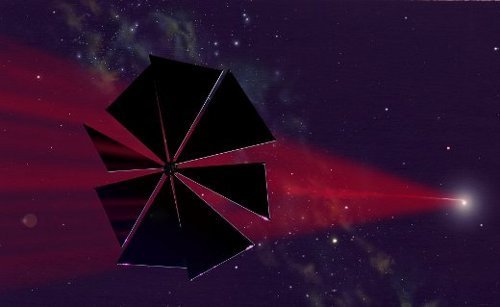
Image: An interstellar sail pushed by laser or microwave. Credit: Michael Carroll.
Freeman Dyson proposed that interstellar vehicles use “gravity machines”, swinging by massive stars that would accelerate them and fling them onward in new directions. T.A. Heppenheimer, author of Colonies in Space, has pointed out that an interstellar probe aimed at one nearby star could, in some cases, be slung onward to another in a game of celestial billiards. Engineer Peter Bielkowicz has described a hypothetical journey to a nearby neutron star; too close an approach would tear the ship apart.
Starflight, then, may be possible if we do not aim for speeds near that of light. But one can dream, writes aerospace engineer Maxwell Hunter, that the most intriguing question among the engineers and scientists of a future time will be an assault on the light barrier.
Probing the Stars
In 1973, a small group of British scientists and engineers led by Alan Bond, all members of the British Interplanetary Society, set out to design an interstellar probe based on foreseeable technology. The requirements were that the probe traverse the 6 light year distance to Barnard’s Star within 50 years, deploy sensors, and radio its findings back to Earth. The study was named Project Daedalus, after the mythical Greek artificer who escaped from Crete on wings made of feathers and wax (his son, Icarus, fell from the sky when he flew too close to the Sun).
The B.I.S. Starship Study, published in 1978, described a colossal two-stage vehicle weighing almost 3,000 tons without fuel. Half of each stage would be an engine, consisting of a device to inject 250 small pellets of deuterium and helium-3 a second into the center of a bell-shaped combustion chamber hundreds of feet across. Electron beams would zap the pellets, causing them to implode and fuse, producing a continuing series of small thermonuclear blasts that would accelerate the starship out of our solar system. The first stage would fire for two years before it dropped off; the second would accelerate for another year and three quarters. After reaching over 12 per cent of the speed of light, the probe would coast the rest of the way, managed by an advanced on-board computer with characteristics of an artificial intelligence, and tended by large maneuverable robots called wardens. The probe would flash through the Barnard’s Star system in a few hours, launching up to 18 sub-probes to study that star and the planets that may circle it. The main probe, by then well beyond Barnard’s Star, would collect the information and radio it back to our solar system, where it would be received six years later.
The study team concluded that the Daedalus probe would require the resources of a society richer than humanity is today, and one with improved spaceflight capabilities — perhaps a solar system civilization. The most feasible source of large quantities of helium-3 appears to be the atmosphere of Jupiter, where compressors hung from giant balloons would collect the gas. The probe itself would have to be assembled and launched from an orbit around Jupiter or one of its moons.
The authors believe that such a probe would not be built or launched until well into the next century. Still, some people have suggested that the Daedalus report is the first step toward putting interstellar flight on a sound engineering basis. It may be comparable to the 1937-1939 British Interplanetary Society Moonship Study that had so many parallels in the Apollo project 30 years later. The B.I.S. Journal now publishes four “Interstellar Studies” issues each year, filled with technical articles and essays on interstellar travel and communication. [Editor’s note: JBIS remains an active venue for interstellar studies under the editorship of Kelvin Long].
Americans too have been active in laying the groundwork for interstellar probes. In 1975, Hughes Research Laboratory physicist Robert Forward proposed a 50 year national program of interstellar exploration, using small probes that might achieve a third of light speed. Forward pointed out that the continuing miniaturization of electronics might allow probe payloads to weigh only a few hundred pounds instead of many tons, drastically reducing the energy requirements for their propulsion. On arrival, a Forward probe would brake into orbit around the most interesting planet; its compact mass would open up into a silvery mesh, a spherical network of interconnected sensors and computer elements over 300 feet across. This latticework probe might use a laser to drive part of its mesh down through the atmosphere to the surface, and relay the sensors’ findings back to our solar system.
Before we launch probes to the stars, we might first take shorter steps out into the interstellar environment. Pioneer 10 and the Voyager probes will send back some information about this unexplored territory before their signals become too faint. In 1970, spaceflight pioneer Krafft Ehricke suggested an “ultraplanetary” probe that would swing around Jupiter or the Sun before flying out into the interstellar cold. Leonard Jaffe of the Jet Propulsion Laboratory in Pasadena recently led a study of an interstellar “precursor” mission that would fly by Pluto and head outward in the direction of the Sun’s motion through the Galaxy, like a scout sent ahead of our civilization. Forward has suggested that we send a probe beyond the solar system and then bring it back in, to see if it is smart enough to detect life.
Why Probes?
The scientific motivation for interstellar probes stems from the limits of astronomy. With telescopes alone, we can never be sure what lies within other solar systems, or if their planets have evolved life and civilization. The most important reason for interstellar probes, says “Interstellar Studies” editor Anthony R. Martin, is simply to see what is out there.
Interstellar probes may become major tools in the search for life and intelligence in the galaxy. In 1966, American astronomer Carl Sagan and Soviet astronomer Iosif Shklovskii argued that, within a few hundred years, humanity could launch probes to all nearby stars of interest. Astronomer A.G.W. Cameron, testifying before the U.S. Congress in 1978 on extraterrestrial intelligence research, said that we might have to use interstellar probes in our search for alien life.
In 1960, radio astronomer Ronald Bracewell suggested that an advanced alien civilization, instead of listening from its home system for radio messages, might send long-lived probes to orbit other stars, to listen for intelligent signals, and to reply if they heard any.
The most important reason for interstellar probes is one even proponents are reluctant to state, for fear of appearing overly ambitious. It is to find new worlds for humanity. RAND Corporation engineer Stephen Dole, in a book with Isaac Asimov titled Planets for Man, estimated that there might be 600 million habitable planets in our galaxy. The nearest star with such a planet may be, on the basis of averaging, only 20 or 30 light years away. If we send probes into the life zones of favorable temperatures around nearby stars, we will be looking as much toward our own future as toward the discovery of aliens.
It is not attractive to send manned starships solely to explore; they would have to be larger and more elaborately equipped than robot craft, increasing their cost. And they would have to make round trips, shortening their range and limiting exploration to the nearest stars. Better to send one-way, expendable unmanned probes to fly by their targets, or to enter looping orbits around other stars, spreading wings of solar cells, and beeping back information to giant antennas in our solar system.
There is only one convincing reason for manned starflight: the colonization of other star systems. We can only guess why our descendants would make this effort. It may be the result of an impending disaster; the pressure of population, conflict or oppression within a solar system civilization; contact with extraterrestrials; or some grander vision of the human role in the universe. Except in an emergency, manned starships would not fly until robot probes told us of a hospitable environment But once we find a new habitat for Humankind in the stars, there may be no turning back.
The Outleap
“Warp Factor Five, Mr. Sulu.”
Science fiction, in showing humans traveling between the stars, has resorted to gimmicks to get around the light barrier. It is full of “space warps” and “hyperspace drives”, “stargates”, and “jumps” through other dimensions of space-time like that made by Han Solo’s Milennium Falcon in Star Wars.
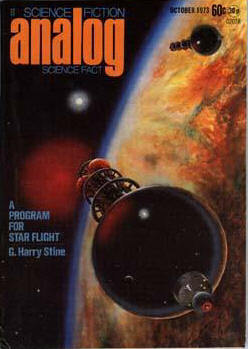
The reality may not be so neat. Early starships carrying human pioneers may be slow boats to Centauri, making perhaps 1/100 the speed of light. Journeys may take centuries. This leads to the concept of the “generation ship”, in which the original crew dies en route, but is succeeded by generation after generation until the space ark finally makes planetfall. Scottish astronomer John MacVey, in Journey to Alpha Centauri, described a pair of giant starships, each carrying 3,000 people to a planet in the nearest star system. Robert Enzmann proposed a convoy of ten ships, aimed at stars where probes had found gas giant planets similar to our Jupiter. Each ship would start with 200 people, but that would grow to 2,000 during the long voyage. G. Harry Stine, expanding on Enzmann’s ideas, suggested that starships failing to find a habitable planet could refuel from a gas giant and head outward to their next destination, on a voyage of uncertain duration.
Image: The Enzmann starship, as pictured on the cover of the October, 1973 issue of Analog, the issue that included Harry Stine’s ideas on interstellar expansion. Cover art by Rick Sternbach.
Interstellar arks might be self-propelled space colonies, like the rotating globular or cylindrical habitats proposed by Princeton physicist Gerard O’Neill, equipped with powerful engines for interstellar flight. The migrants might even hollow out an asteroid, converting much of its interior to reaction mass for a propulsion system.
But could such isolated islands of humanity survive these journeys? No one yet knows how to design a large closed ecology, though the Soviets have kept men in space for six months. Starship societies might become very ingrown; tensions might rise as the initial enthusiasm waned, and middle generations faced the prospect of a journey which, for them, would have neither beginning nor end. The ship would become the totality of their existence. Robert Heinlein, in his 1940 science fiction story “Universe”, suggested that passengers might forget where they were going, and why.
Aging research may bring an extension of the average human lifespan, removing the 50 to 70 year limit on manned interstellar flight. But would crews remain sane during a voyage of centuries? We may need more drastic solutions.
One is suspended animation. The metabolisms of the colonists might be stopped or drastically slowed by new biomedical techniques. These might include cryonics — the freezing of human beings. By making time irrelevant, cryonics could open the road to the stars. Even hibernation would help, by reducing the amount of waking time and the consumption of supplies. But we do not yet have reliable techniques for suspending human metabolism over long periods, or freezing and thawing human bodies without damage.
Science and science fiction writers have suggested that we get around these problems by not sending adult humans at all, but carefully protected ova and sperm. Near the target system, they would be united to become children, to be raised by a motherly computer until they were ready to set foot on a new world, like a second Adam and Eve.
If future humans make breakthroughs in propulsion allowing travel at speeds more than half that of light, they could exploit the effects of relativity. To a hypothetical stationary observer, it would appear that time was passing more slowly inside the starship than on Earth, though the passengers would not notice any difference in their lives. Because of this time dilation, the star travelers would age more slowly than their friends and relatives.
The Challenge of the Starship
Why do humans design starships? Not for material reward; they get no government grants, or fat contracts. It does not help their professional careers; other scientists criticize their proposals as being unrealistic or even outrageous. Our Space Agency funds no work on interstellar flight; NASA advanced planner Jesco von Puttkamer calls it “the wildest science fiction”. While the ebullient Forward hopes to see the first interstellar probe launched before he retires in 1998, few starship designers expect quick results from their work, and none are likely to visit other suns. Yet they persist, a small band of pioneers, from diverse origins, working in their spare time, sharing a common passion. [Editor's note: Bob Forward, alas, did not see his dream realized. The interstellar theorist died in 2002].
To a physicist or an engineer, the starship is the ultimate challenge. Making it work, at least on paper, is an intense intellectual pleasure. Designers must defeat time and space through the application of human intellect and technology. They work on the largest scales imaginable, speaking of light years, and energies that dwarf our hydrogen bombs. The ships themselves range from the shimmering lattices of Forward’s mini-probes to the colossi of Enzmann, each pushing a 12 million ton iceberg of frozen deuterium.
Interstellar travel forces us to the edge of science, to exotic physical concepts. Some astrophysicists have speculated that black holes, the massive collapsed stars that suck in even their own light, might have exit points elsewhere in the universe, perhaps in white holes that gush out matter and energy. In The Cosmic Connection, Carl Sagan speculated that advanced civilizations might use a black hole transport system, like a subway through the universe. Science writer Adrian Berry, in The Iron Sun, even proposed that humans build their own black holes outside our solar system. Texas physicist John Wheeler suggested that different points in space-time might be connected by “worm-holes”, tiny, short-cut passages.
Recent work has cast doubt on the utility of these concepts for interstellar transportation. But the speculation goes on. Forward wonders if we might someday escape the chains of gravity and inertia, and not be limited to what he calls “the slow crawl of light”.
Ad Astra
Though few starship designers will say so, there is hidden in their work a transcendental idea: that humans should expand outward to explore and colonize the galaxy. Bob Parkinson, a member of the Daedalus team, describes the starship as a philosophical vehicle, the endpoint of a process that began with the physical exploration of the world in the Renaissance.
M.I.T. astrophysicist Philip Morrison criticizes the idea that humanity must expand, naming such a concept “Malthusian” after the grim parson who argued that living things increase until they meet the limits of their food supply. Carl Sagan calls it human chauvinism. But our politically divided species, dangerously armed, may need a grand idea that would define humanity as a whole by contrast with an outside it could explore and settle. Aiming for the stars would force us, constructively, into longer time scales of social endeavor. A star-faring society, writes Parkinson, would have to plan its future not in years and decades, but in centuries and millennia. Such a civilization would have to believe in itself.
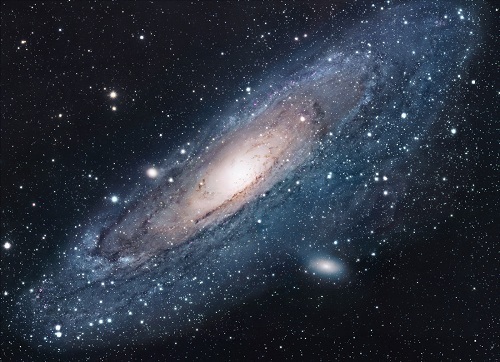
Image: M31, the nearest galaxy to our own. Is it an imperative of intelligence to move outward and explore such vast regions? Credit: Robert Gendler.
There also is an appeal to deep human drives in the extension of human influence and purpose outward into an inanimate universe, the victory of mind over mindlessness. But Dyson, with typically elegant simplicity, says starflight is not a property of our species; it is life’s way of moving around the universe.
The key to expansion will lie in our minds, in our conceptions of what humans can and should be. We may learn to think of our solar system as an inland sea at the edge of the interstellar ocean. We may come to see the stars as lighthouses in the cosmic darkness, welcoming fires in the coldness of the void, furnaces for new civilizations. Eventually, a patient outside observer might see ripples of intelligent activity spreading through the galaxy, from a central disturbance called Earth.
Science fiction publisher Donald Wollheim has noted a widely shared vision of the human future among science fiction writers. This future history begins with journeys to the planets and their colonization, and extends to interstellar travel, star colonies, and the formation of a human galactic empire.
This may be too ambitious for a species of our modest abilities. But if we choose to journey out, however far we go, it will begin with the starships of the mind.






February 21, 2013
Small Planets Confirm Kepler’s Capabilities
The planetary system around Kepler-37, some 210 light years from Earth in the constellation Lyra, had its place in the media spotlight yesterday, although it will surely be a brief one. But it’s heartening to see the quickening interest in exoplanets that each new discovery brings. Will the interest continue? In the Apollo days, public enthusiasm reached a frenzy as we moved toward the first lunar landings, then plummeted. What the media see as the big event in exoplanetary science is the discovery of a terrestrial world around a star like the Sun. Let’s hope there is no similar letdown afterwards.
After all, we’re getting close, and discoveries like those announced yesterday remind us that Kepler can find very small worlds indeed. Kepler-37b lays claim to being the smallest planet yet found around a star similar to the Sun, similar in this case meaning a G-class star with a radius about three-quarter’s of the Sun’s. The new planet is just a bit larger than our Moon, as the image below shows. The world is assumed to be rocky and, with a 13-day orbit, its surface temperature is probably in the range of 700 K.
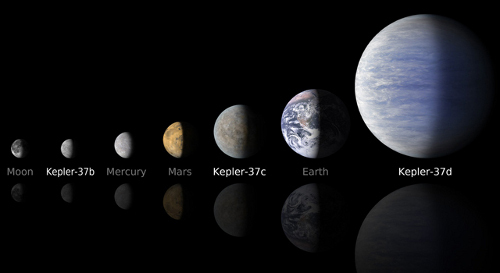
Image: NASA’s Kepler mission has discovered a new planetary system that is home to the smallest planet yet found around a star like our sun, approximately 210 light-years away in the constellation Lyra. The line-up above compares artist’s concepts of the planets in the Kepler-37 system to the moon and planets in the Solar System. The smallest planet, Kepler-37b, is slightly larger than our moon, measuring about one-third the size of Earth. Kepler-37c, the second planet, is slightly smaller than Venus, measuring almost three-quarters the size of Earth. Kepler-37d, the third planet, is twice the size of Earth. Credit: NASA/Ames/JPL-Caltech.
As you can see from the image, we have three new worlds all told, all of them orbiting at a distance less than Mercury’s distance to the Sun. Kepler-37c orbits the star every 21 days, while Kepler-37d, probably a Neptune-class world, orbits every 40 days. A fourth candidate, identified as KOI-245.04 in the most recent Kepler planet catalog, is now disregarded, thought to be the result of random noise, starspot activity on Kepler-37, or instrumental artifacts.
Variable starlight can confuse transit detections, particularly of tiny worlds like Kepler-37b. Fortunately, Kepler-37 is both bright and quiet, allowing the methods of asteroseismology to be brought into play. The oscillations caused by sound waves generated beneath the stellar surface appear as a flickering of the star’s brightness. These measurements are tricky to observe in smaller stars, but making them allows the team to calculate the radius of Kepler-37 to a three percent accuracy. That, in turn, gives us accurate readings of the planetary radii in the system.
All of this is good news, for it implies that Kepler will be able to find Earth-sized planets in longer orbits around Sun-like stars. Once we begin finding them, is the public going to get exoplanet fatigue just as it lost interest in the Moon after Apollo? Astronomer John Johnson (Caltech) takes note of the possibility in this article in the Los Angeles Times:
“I don’t think anyone would have been taken seriously if they had said, before Kepler launched, that we’d find planets as small as Mercury,” he said. Mercury is slightly larger than Earth’s moon.
The telescope has revolutionized astronomers’ notions of our galaxy as a place that must be “teeming with rocky planets” that seem to be “a natural outgrowth of star formation,” he added.
Indeed, Kepler has been so prolific that many space enthusiasts have become blasé about exoplanet discoveries just as scientists are closing in on finding truly Earth-like worlds, Johnson said.
“Every one of these detections was unimaginable in 2008,” he said. “Every one of these is super-important.”
The paper is Barclay et al., “A sub-Mercury sized exoplanet,” published online in Nature 20 February 2013 (abstract).






February 20, 2013
Resources Between the Stars
Yesterday we looked at the possibility of colonizing worlds much different from the Earth. Seen in one light, pushing out into the Kuiper Belt and building settlements there is part of a slow migration to the stars that may occur without necessarily being driven by that purpose. Seen in another, experimenting with human settlements in extreme environments is a way of exploiting the resources of nearby space, pushing the human presence out into the Oort Cloud. Either way, we can find places that, while not ‘habitable’ in the classic sense of liquid water at the surface, are nonetheless colonizable.
In his Tale of Two Worlds, novelist Karl Schroeder works on a definition of a colonizable world. It has to have an accessible surface, for one thing, meaning one we can work with — obviously a surface gravity of 4 g’s is going to be a problem. Much smaller worlds like Pluto, as we saw yesterday in Ken Roy’s work on possible colonies there, pose less of a challenge, as we can imagine strategies to produce one g for the inhabitants. Schroeder also notes there has to be a manageable flow of energy at the surface in which we can move heat around. That seems reasonable enough, although advanced technologies will have a wider zone than we have.
But I found Schroeder’s third point interesting. Here he’s drawing on a 1978 paper in Science called “The Age of Substitutibility,” by Harold Goeller and Alvin Weinberg (Oak Ridge National Laboratory), in which the authors describe the artificial mineral they call ‘demandite.’ It comes, as Schroeder notes, in two forms:
A molecule of industrial demandite would contain all the elements necessary for industrial manufacturing and construction, in the proportions that you’d get if you took, say, an average city and ground it up into a fine pulp. There’re about 20 elements in industrial demandite including carbon, iron, sodium, chlorine etc. Biological demandite, on the other hand, is made up almost entirely of just six elements: hydrogen, oxygen, carbon, nitrogen, phosphorus and sulfur. (If you ground up an entire ecosystem and looked at the proportions of these elements making it up, you could in fact find an existing molecule that has exactly the same proportions. It’s called cellulose.)
The point is that the right elements have to be accessible on the object you’re trying to live on to make it colonizable. Now if you can find a place that meets the three criteria, surprising things can happen. Centauri B b looks to be a nightmarish place, probably tidally locked and roiling with lava on its day side, and almost certainly without a breathable atmosphere. But from the standpoint of colonizability, we can’t rule out the night side, and the fact that this (still unconfirmed) world has a surface gravity about the same as Earth’s also works in its favor.
From the Kuiper Belt Past Proxima
Ken Roy’s talk at Huntsville looked at places that seemed equally inhospitable, but which may have the necessary resources to provide an advanced human civilization with what it needs to create settlements there, whether as part of a deliberate interstellar migration or simple exploration. Yesterday I focused on Pluto, but of course the Kuiper Belt is stuffed with objects, hundreds of which may be Pluto-sized, while cometary bodies in the Oort Cloud are thought to number in the trillions, based on the study of long-period comets and their frequency.
Like Schroeder, Roy is interested in brown dwarf possibilities as well. The odds on our finding a brown dwarf closer than Proxima Centauri are dwindling, though I don’t think we can rule out a possible ultra-cool Y dwarf in this space (please correct me with any updated information). In any event, the WISE mission (Wide-field Infared Survey Explorer) has shown us that brown dwarfs are less common than we thought. WISE has discovered 200 brown dwarfs (including 13 Y dwarfs), 33 of which are within 26 light years of the Sun. Given that there are 211 stars in the same volume of space, we’ve found that there are about six stars for every brown dwarf.
If they’re not as abundant as we had thought, brown dwarfs may still become useful staging areas for far-future interstellar expeditions, for we know that some have accretion disks that indicate the possibility of planet formation. I’ve written before about brown dwarf habitable zones (see Brown Dwarfs and Habitability), but Roy’s point is that whether or not we find a world that’s habitable in the classic sense, we can still assume we’ll find the same kind of small, icy planets we see in our own Kuiper Belt, and the same technologies could exploit them.
Roy is one of those intrigued with the idea of ‘rogue’ planets that move through the interstellar deep far from any star. We know little about these worlds, but it’s assumed that great numbers of them are out there, doubtless the result of gravitational interactions in young solar systems that caused them to be ejected. Dorian Abbot and Eric Switzer (University of Chicago) call these ‘steppenwolf’ planets because they ‘exist like a lone wolf wandering over the galactic steppe.’

Image: A ‘steppenwolf’ planet moving between the stars. Credit: NASA/JPL-Caltech.
Louis Strigari (Stanford University) has estimated that as many as 105 objects larger than Pluto exist for every main sequence star. If that’s anywhere like the case, then rogue planets ranging between the size of Ceres and Jupiter should be out there in abundance, and we can hope to put some constraints on their numbers through future gravitational microlensing surveys and even exoplanet transit studies, which may catch a rogue planet’s transit. Some studies show that radiogenic heating from the planetary core could keep an ocean under crustal ice liquid for billions of years even out here, where there is no star to provide warmth.
Deep space is not without resources, as we’re learning every day. Roy told the audience in Huntsville that cometary objects from the Kuiper Belt to the Oort Cloud should offer CO2, ammonia, methane, oxygen, carbon and nitrogen, while we can exploit asteroids for silicates and metals. We can only imagine what resources might be available in unattached worlds moving between the stars. This is all work for a civilization that has built a thriving deep space infrastructure, but then, thinking about the future is what we do here.






February 19, 2013
Interstellar Expansion: Colonizing Ice Dwarfs
Are habitable planets the best places to look for life? The question seems odd, because we’re assuming life has to have clement conditions to emerge and survive. But step beyond the question of life’s formation and the issue can be framed differently. Where beyond its birthplace might life migrate? In SETI terms, where might we look for the signature of a civilization advanced enough to move beyond its home world and expand between the stars?
A lot of ideas seem to be converging here. In Huntsville, Ken Roy (whose description at the recent interstellar conference was ‘an engineer living and working amidst the relics of the Manhattan Project in Oak Ridge, Tennessee’) described potential habitats stretching far out into the Solar System and beyond. Roy has been working for some time with Robert Kennedy and David Fields on colonization scenarios.
My own talk covered the kind of places where we might extract resources, ranging from icy dwarfs like Pluto to cometary objects and ‘rogue’ planets without any star. And science fiction author Karl Schroeder, in a recent blog post called A Tale of Two Worlds, also brought the topic up. Let me quote Schroeder, because I want to return to his post in a day or so:
…it’s important to bear in mind that habitability and colonizability are not the same thing. Nobody seems to be doing this; I can’t find any term but habitability used to describe the exoplanets we’re finding. Whether a planet is habitable according to the current definition of the term has nothing to do with whether humans could settle there. So, the term applies to places that are vitally important for study; but it doesn’t necessarily apply to places we might want to go.
Both Schroeder and Roy are assuming not near-term projects but the kind of settlement and terraforming that draw on huge resources of energy. The premise, in other words, is that we’re talking about a culture that ranges freely through its own system, having mastered fusion or other technologies and being capable of large-scale building projects in space and on planetary or other surfaces. Grant that premise and then think about what kind of structures it might make sense to build when exploiting local resources and looking out toward the stars.
Pluto and the Ice Dwarfs
Pluto is a case in point. Here we have a surface that appears to be a shell of nitrogen ice covering water ice. When New Horizons gets to the Pluto/Charon binary in 2015, one thing to look for is an equatorial bulge that could have been left over from the early days of Pluto’s formation. No bulge makes the case for stretching of the ice shell over Pluto’s lifetime, strengthening the possibility some are noting that the ice dwarf could contain an ocean beneath about 165 kilometers of crust, an ocean that may be just as deep as the crust is thick (see The Case for Pluto’s Ocean for more).
As Roy told the crowd in Huntsville, icy worlds like Pluto are rich in volatiles, and of the tens, if not hundreds of thousands of Kuiper Belt objects out there between 30 and 50 AU, several hundred may be Pluto-size. Such worlds are doubtless common not just here in our own system but as rogue planets in interstellar space and perhaps circling brown dwarfs, those dim objects that blur the distinction between gas giants like Jupiter and true stars like Proxima Centauri.
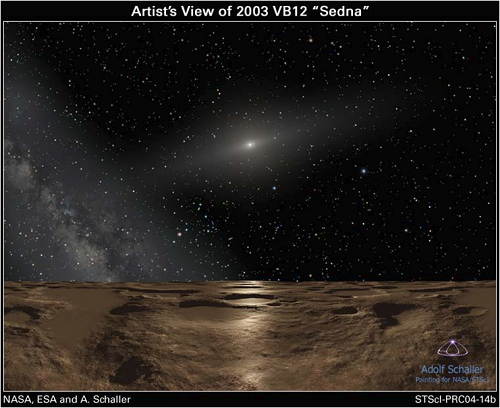
Image: This artist’s conception of the ‘scattered disk’ object Sedna reminds us that even beyond the Kuiper Belt and as we move into the Oort Cloud, vast numbers of icy objects are thought to exist. Can we exploit these as we move outward toward another star?
Build a settlement on an ice dwarf in the outer system and you are not only creating space for living and doing science, but also building the technologies that will one day be used in interstellar colonization missions. But Roy noted that the science fictional image of a domed city in a harsh landscape just won’t work here. Induce Earth-class atmospheric pressure inside such a dome and even a small one (1000 feet in radius) would require a four-inch thick layer of steel to keep the dome intact. Moreover, ice dwarfs have but feeble gravity, creating medical issues from muscle atrophy to bone problems, loss of body mass, sleep disturbance and more. A better choice, then, is to move inward, creating the colony deep within the ice dwarf itself.
At 160 meters, the ceiling of a colony hollowed out within Pluto would be fully supported by the air pressure inside. Artificial light would be essential, of course, and we still have a gravity problem, for Pluto’s gravity is only 6.7 percent that of the Earth — a 200 pound person on Earth weighs but 14 pounds on Pluto. Roy suggests a rotating torus in this setting could provide living and working spaces at 1 Earth gravity. At 1 revolution per minute, a 1790-meter torus supported by maglev rails could accommodate, by Roy’s estimation, 10,000 people living in conditions that would more or less resemble the worldships so often imagined by science fiction writers.
We’re assuming technologies that can create large rotating structures in low-gravity environments, with the ability to move spacecraft at velocities of 0.001 c to build and supply the colony. We’re also assuming proven fusion power plants and considerable expertise in mining and construction. We would put these tools to work to extract local silicates and metals from the surface and, perhaps, rock from buried impactors. We would be working in an environment rich in H2O, but also in methanol, hydrogen cyanide, formaldehyde, ethanol, ethane and long-chain hydrocarbons, all within a salty ice mantle.
Interstellar Migration
Here’s long-haul migration to the stars presented as a series of steps at 0.001 c. Moving roughly 400 AU at a time between various objects in the outer system and, eventually, interstellar space, we spend 50 years at each to establish a colony and then build and crew another ship. The 4.2 light years to Proxima Centauri in this scenario demands 664 such jumps and reaches the star in 38,000 years, leaving a chain of colony worlds behind that are self-sustaining.
The technologies needed for this kind of expansion are well beyond us, but it is not inconceivable that more advanced cultures as they move up the Kardashev scale may have accomplished such things. Places that are habitable, as Karl Schroeder says, are not the same thing as places that are colonizable, and it’s also true that we have to be wary of imputing human motivation to hypothetical extraterrestrial civilizations. Their detectable artifacts, in other words, might extend between the stars far into the interstellar deep and so, in some remote futurity, might ours.






February 18, 2013
Near-Misses and their Uses
We can hope that the celestial events of February 15, including the spectacular fireball over Chelyabinsk and the near-miss from asteroid 2012 DA14, have raised public consciousness about Earth’s neighbors in space. And indeed, this seems to be the case. Media outlets were flooded with articles, photos and video, and talk show hosts found themselves asking what could be done to prevent future impacts. Could all of this prompt a new surge of interest in space?
The scenario is exactly what Arthur C. Clarke wrote about in Rendezvous with Rama (1972), where what it takes for humanity to get serious about developing a protective system (and, by extension, about pushing its space program forward) is an impact. We can be grateful that the one we’ve just seen was far smaller than Clarke’s, as described in the first chapter of the novel:
At 0946 GMT on the morning of September 11 in the exceptionally beautiful summer of the year 2077, most of the inhabitants of Europe saw a dazzling fireball appear in the eastern sky. Within seconds it was brighter than the Sun, and as it moved across the heavens — at first in utter silence — it left behind it a churning column of dust and smoke.
Somewhere above Austria it began to disintegrate, producing a series of concussions so violent that more than a million people had their hearing permanently damaged. They were the lucky ones.
Clarke goes on to recount the impact in northern Italy, where Padua, Verona and Venice are destroyed by the combination of impact and tsunami. The deaths of 600,000 people and the great chunk torn out of human history create a resolution that this must not happen again, and out of this is born the system of radars that eventually finds the alien intruder dubbed Rama. Clarke’s book is about the encounter with this enigmatic vessel, but the asteroid-warning radars he imagines create the kind of warning grid we may eventually put in place.
The B612 Foundation has been making the case for asteroid detection and mitigation studies for some years now. Its Sentinel Space Telescope is scheduled for launch in 2018, with the aim of detecting over 90 percent of asteroids over 100 meters in diameter — these are the ones large enough to destroy an entire region of the planet if they were to hit us. Sentinel also aims to track more than 50 percent of near-Earth asteroids in the DA-14 category. With decades of warning, says CEO Ed Lu in this B612 news release, we can use existing technology to destroy or alter the trajectory of any such objects.
Chelyabinsk and 2012 DA14 also put the University of Hawaii at Manoa’s work on ATLAS into the news. The Asteroid Terrestrial-Impact Last Alert System — an ominous title, that — is to operate eight telescopes, each with a camera of up to 100 megapixels, on sites in the Hawaiian Islands. The goal here is to offer, according to this news release from the university’s Institute for Astronomy in Honolulu, a one-week warning for a 45-meter asteroid and a three-week warning for a 140-meter object. That’s enough time, according to astronomer John Tonry, “to evacuate the area of people, take measures to protect buildings and other infrastructure, and be alert to a tsunami danger generated by ocean impacts.”
But among the spate of asteroid warning news items that surged over the weekend, the project that caught my eye first was one called DE-STAR, the explanation of whose acronym is so tortuous that I will direct you to the University of California at Santa Barbara news release it appeared in. What UC-Santa Barbara researchers Philip Lubin and Gary Hughes are proposing is a system that could, over the course of a year, destroy asteroids ten times larger than 2012 DA14, using a massive phased array of lasers to break up or evaporate the object.
Says Hughes:
“This system is not some far-out idea from Star Trek. All the components of this system pretty much exist today. Maybe not quite at the scale that we’d need –– scaling up would be the challenge –– but the basic elements are all there and ready to go. We just need to put them into a larger system to be effective, and once the system is there, it can do so many things.”
DE-STAR is being described as a ‘directed energy orbital defense system,’ one that uses solar energy to feed its lasers. The researchers have calculated DE-STAR systems in various configurations, including a 100-meter DE-STAR 2 and a 10-kilometer DE-STAR 4, the latter capable of delivering the energy needed to obliterate a 500-meter asteroid in about a year.
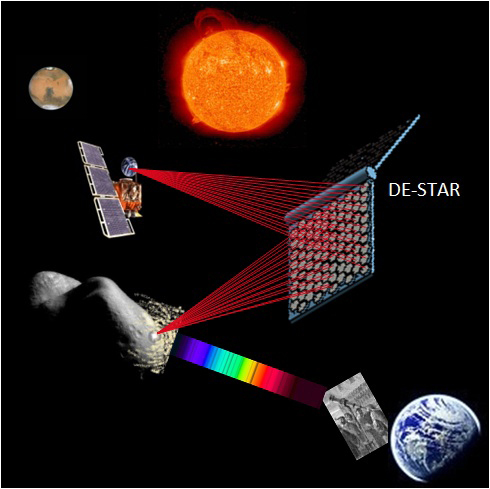
Image: Concept drawing of the DE-STAR system engaging both an asteroid for evaporation or composition analysis, and simultaneously propelling an interplanetary spacecraft. Courtesy Philip M. Lubin.
And now we start getting into Bob Forward territory as Lubin and Hughes go on to describe a DE-STAR 6 that would function not only in asteroid defense but as the propulsion system of an interstellar spacecraft, beaming enough laser energy to the craft to get it up to a substantial percentage of the speed of light. An asteroid mitigation strategy that involved planetary safety, power generation and spacecraft propulsion is a tempting long-term goal, but a DE-STAR 2 about the size of the International Space Station could begin small-scale trajectory alterations on a variety of objects as we experiment with planet-defending techniques.
Meanwhile, many of us talked to Claudio Maccone at the Huntsville conference and learned of his plans to attend the IAA’s Planetary Defense Conference, coming up in Flagstaff on April 15-19. Claudio crosses the ocean all the time, as inveterate a conference-goer as I’ve ever seen, but who would have thought this year’s Planetary Defense meeting would become so highly visible? You can bet media coverage at Flagstaff will be considerably higher than in years past thanks to Chelyabinsk and 2012 DA14, making them unusually effective wake-up calls for our species.






February 15, 2013
Alpha Centauri Sunrise
If the title of this piece conjures up exotic images, that’s all to the good. In fact, I’m surprised that “Alpha Centauri Sunrise” hasn’t been the title of a science fiction story somewhere along the line, but a quick check shows no such reference. Thus when Robert Kennedy (The Ultimax Group) created a drink called the Alpha Centauri Sunrise at our recent conclave in Huntsville, he was breaking new ground. And maybe images of a double sunrise also came to mind, the view from an as yet undiscovered world where Centauri A is a bright flare in the morning sky while a still closer Centauri B begins to nudge up over the hills, flooding the scene with orange light.
And what happened to Proxima Centauri? It would not be a factor in a scene like that, its light so dim that it would not stand out from other stars in a completely dark sky. Only its proper motion would alert local astronomers to how close it was (roughly 15000 AU). But let’s drink to Proxima anyway. I promised the recipe for the Alpha Centauri Sunrise two weeks ago and it’s time to deliver, as a number of readers have reminded me. Here we have it, from the pen (or keyboard) of Robert Kennedy himself:
The Alpha Centauri Sunrise
Best served in a martini glass or a champagne flute to accentuate the color gradient.
Ingredients:
1 jigger Tennessee moonshine;
2 jiggers Red Bull (different cognate but Centauri sorta suggests a bull, plus one of the stars is reddish);
4-6 oz. orange juice;
½ tsp. grenadine (to make the red-to-yellow color gradient);
three little red berries (to represent the three suns of the triple star system: α Centauri A, α Centauri B, and Proxima Centauri.
If, after all these puns, your customer still doesn’t crack a smile, then instead of three little red berries, give him a big raspberry (literally or figuratively).
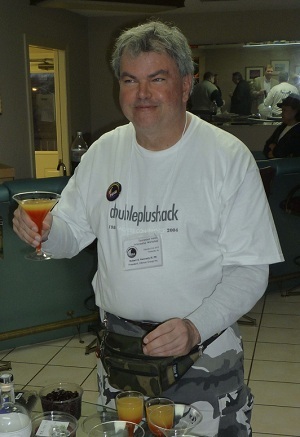
With an Alpha Centauri Sunrise in hand, you might want to recall some of the great science fiction venues where drinks like this might be served. Callahan’s Place is the creation of Spider Robinson (it’s immortalized in Callahan’s Crosstime Saloon), a place where time travelers make the occasional appearance and aliens from a variety of worlds might wander in at any time. Robinson devotees will recognize ‘Callahan’s Law’: “Shared pain is lessened, shared joy, increased – thus do we refute entropy.” And I would say that refuting entropy is a task worth accomplishing.
Callahan’s, of course, had forerunners, among them Gavagan’s Bar, which was the work of Fletcher Pratt and L. Sprague de Camp, depicted in a series of tall tales (most of them, I believe, written for John Campbell’s Unknown) and collected into a 1953 book. The one that comes most readily to my mind, though, is Arthur C. Clarke’s Tales from the White Hart, a 1957 collection that brought science fiction and pub culture to a triumphant peak. These stories are still lively today, and recall a time when the members of the British Interplanetary Society and science fiction fans met regularly at such venues.
Image: Alpha Centauri Sunrise creator Robert Kennedy with the finished product.
Of course there are wonderful movie and TV bars in science fiction, from the Mos Eisley Cantina on Tatooine (Star Wars) to Star Trek’s Ten Forward, which is where I would have spent my time on the Enterprise whenever possible. But Britain’s pub culture gave birth not only to Clarke’s Harry Purvis, the raconteur who spun his tales, but also to the British Interplanetary Society’s later work on Project Daedalus, the fusion starship design. Much of their work took place in a pub called the Mason’s Arms, where propulsion concepts and target stars offered just as magical a look at reality as anything in the White Hart. Thus it’s written SF and the White Hart I come back to when thinking of starships and bars.
Harry Purvis could hardly have had better companions than I had in Huntsville. Looking toward next week, I’ll be tapping the ideas of one of these, Ken Roy (The Ultimax Group), whose thoughts on colonizing outer system and deep space objects dovetail beautifully into my own thinking on gradual expansion into the Oort Cloud. Ken is a frequent contributor with colleagues Robert Kennedy and David Fields in venues like JBIS and Acta Astronautica. We’ll soon be looking at an unusual take on terraforming and how it might transform human expansion.
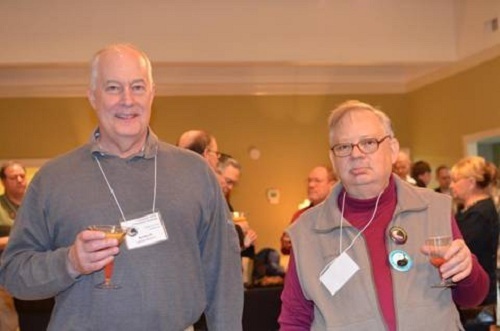
Image: Robert Kennedy’s co-author Ken Roy (left) and ‘neighbor/fellow habitué of the Friday Night Dinner Club’ John Preston, with Alpha Centauri Sunrises in hand.






February 14, 2013
The Draco Kill Shot
When I was in Huntsville for the recent interstellar conference, I noticed people walking around with black rubber wristbands that said ‘Build a Star Ship.’ Space educator Mike Mongo was handing these out to all concerned, and I soon picked one up to give my grandson. They’re an interesting form of marketing — leave these in the right places and kids pick them up. Maybe it becomes a fad to wear them. The point is, you never know whose mind you might reach. And maybe once or twice, you give a wristband to a kid who starts dreaming about the stars, and pretty soon that leads to a course of study and then one day a career.
The Roman historian Plutarch said it best: “The mind is not a vessel to be filled, but a fire to be ignited.” And when ignition occurs, it’s often a sudden, passionate event rather than a slow building of sequential ideas. It’s that fire that drives subsequent study and makes long hours amidst the databases and classrooms pay off in the form of eventual insights and discoveries. I’m thinking maybe I’ll get a few more of Mike’s wristbands so my grandson can hand them out at school.
I think about reaching broader audiences every time I attend a conference, and in fact we did have an excellent public session on the last night of the Tennessee Valley Interstellar Workshop. It was held at Calhoun Community College, where Icarus Interstellar’s Bill Cress showed some of the video work he had done to promote the cause. I followed with my talk on gradual migration beyond the Solar System, tapping resources like the Oort cometary cloud and wandering ‘rogue’ planets without stars of their own. We capped the event with a panel discussion led by Les Johnson between Kelvin Long (Institute for Interstellar Studies), Richard Obousy (Icarus Interstellar), veteran space engineer Gordon Woodcock, Bill Kress and myself. The questions raised by the audience were excellent and we could have talked for hours if we had the time.
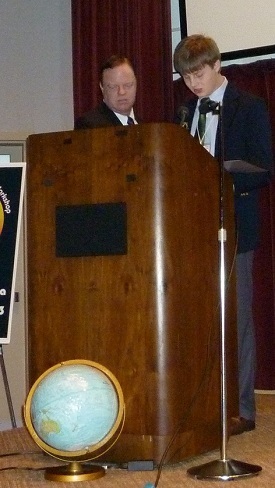
But beyond the public outreach in Huntsville there was a striking example of what I might call public ‘in-reach,’ in the form of William Lucas, a 15-year old high school student who, it is easy to predict, has a bright future ahead of him in whatever field he chooses. Les Johnson made an inspiring choice in scheduling William just after Jan Davis’ keynote address. What William seems to have done is to discover a gamma ray burst before anyone else, leading to a parade of complications with local authorities and even the US Air Force. His presentation was quiet, analytical and used slides and video to great effect. He totally won over his audience.
I’m thinking this is no mean feat. When I was 15 years old, I was reading science fiction magazines, getting crushes on various girls and writing bad poetry. And here was William Lucas, up in front of a room full of scientists and engineers many of whom were old enough to be his grandfather, making a world-class presentation as if this were the kind of thing he did every day. People were buzzing during the break about the skill with which he pulled this off.
Image: William Lucas, presenting his findings at the Tennessee Valley Interstellar Workshop. William’s cousin Paul Sample, who worked with him on the project, is on the left.
The story is this: On March 11, 2011 there occurred the Tōhoku earthquake and tsunami off Japan, leading to the release of radioactive materials at Fukushima, the largest nuclear problem since the Chernobyl disaster of 1986. Monitoring radiation levels around the globe was an imperative, and part of this monitoring took place on Radiation Network, an Internet site that displays radiation levels anywhere in the USA at any particular time. William Lucas is one of the monitors who use geiger counters to take ambient radiation levels, uploading their data automatically in real time using a software package called GeigerGraph.
William’s mother, Diana Neville Lucas, told the audience that her son had had a fascination with geiger counters for years, and he soon talked his parents into supplying him with a geiger counter of the kind used by geologists, one that can track a wide variety of radiation. An active member of Radiation Network, William was interested to see background radiation levels begin to rise during March as fallout from Fukushima moved into the global circulation pattern.
Then, on March 28, there came a sudden spike in the readings. On a calm Monday morning as William was setting out to go to school, levels climbed steadily for an hour far beyond even the enhanced levels caused by Fukushima. The results were automatically reported to the Radiation Network by William’s equipment, and soon his mother received a call from the Huntsville Fire Department saying there was a radiation problem at her house. It was only the beginning. First the Fire Department, then HazMat teams, even a SWAT team from local law enforcement arrived. Last to appear were representatives from the U.S. Air Force.
What exactly was going on at William’s house? After a thorough investigation, the idea that the Lucas family was engaged in some sort of illicit activities involving radioactive materials was disposed of, and in any case, the spike William’s equipment had recorded began to recede. But William was now on the case. Armed with graphs and a satellite view of his home in Huntsville, he described his year-long search for the answer. Google turned out to be the key, although he was sure that finding the answer could not be so simple as merely inserting a date into a search engine. But the method worked.
What William was seeing on his chart was the low curve of fallout from Fukushima with, he believes, a sudden spike caused by a gamma ray burst catalogued as GRB 110328A. The GRB, the result of events that occurred 3.8 billion years ago in the constellation Draco, was detected by the Swift satellite and is considered to be the result of a supermassive black hole destroying a star about the size of our own Sun. Coinciding with his data, the GRB occurred at 1257 UTC on March 28 when Draco was almost directly overhead at William’s location in Huntsville. The young man calmly told a rapt audience that he thereby claimed discovery of the GRB, which later in the day would be traced to Draco by the Swift satellite and subsequently catalogued.
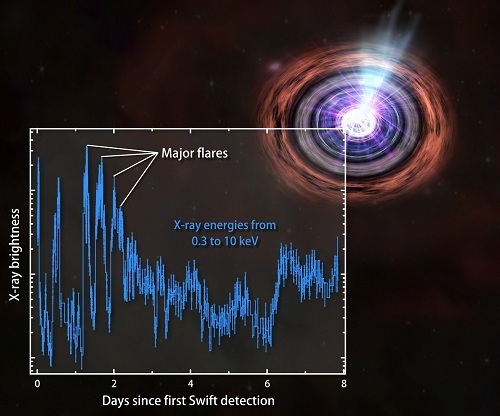
Image: GRB 110328A has repeatedly flared in the days following its discovery by Swift. This plot shows the brightness changes recorded by Swift’s X-ray Telescope. Credit: NASA/Swift/Penn State/J. Kennea.
William calls it the Draco Kill Shot. You can read more about GRB 110328A in NASA Telescopes Join Forces to Observe Unprecedented Explosion, which appeared on the Internet in early April of 2011. It’s considered to be the brightest and longest-lasting GRB ever observed, with high-energy radiation continuing to stream from its location a week after the event. Who would have thought an explosion that occurred 3.8 billion years ago would become part of the home investigations of a high schooler fascinated with radiation? For that matter, who just a few years ago would have dreamed that young minds would have so many useful tools at their disposal?
Today we have amateur astronomers aiding professionals in following up exoplanet finds and networks of people doing everything from cataloguing galaxies to monitoring marine debris and studying arthropods. With the tools of citizen science proliferating, we need to ramp up public outreach to show young people what can be done with modest equipment and dedication. I noticed that William Lucas and parents Diana and Richard stayed for the entire Huntsville workshop, a reminder that public interest once triggered can become a powerful ally in our work.






February 13, 2013
Cultural Diffusion and SETI
What happens to us if our SETI efforts pay off? Numerous scenarios come to mind, all of them speculative, but the range of responses shown in Carl Sagan’s Contact may be something like the real outcome, with people of all descriptions reading into a distant message whatever they want to hear. Robert Lightfoot (South Georgia State College) decided to look at contact scenarios we know something more about, those that actually happened here on Earth. His presentation in Huntsville bore the title “Sorry, We Didn’t Mean to Break Your Culture.”

Known as ‘Sam’ to his friends, Lightfoot is a big, friendly man with an anthropologist’s eye for human nature. His talk made it clear that if we’re going to plan for a possible SETI reception, we should look at what happens when widely separated groups come into contact. Cultural diffusion can happen in two ways, the first being prompted by the exchange of material objects. In the SETI case, however, the non-material diffusion of ideas is the most likely outcome. Lightfoot refers to ‘objects of cultural destruction’ in both categories, noting the distorting effect these can have on a society as unexpected effects invariably appear.
Consider the introduction of Spam to the islands of the Pacific as a result of World War II. The level of obesity, cancer and diabetes soared as cultures that had relied largely on hunting, farming and fishing found themselves in the way of newfound supplies. Visitors to some of these islands still note with curiosity that Spam can be found on the menus of many restaurants. Today more than half of all Pacific islanders are obese, and one in four has diabetes. On the island nation of Tonga, fully 69 percent of the population is considered obese.
Lightfoot mentioned Tonga in his talk, but I drew the above figures from the World Diabetes Foundation. Can we relate the continuing health problems of the region to Spam? Surely it was one of the triggers, but we can also add that the large-scale industrialization of these islands didn’t begin until the 1970s. Imported food and the conversion of farmland to mining and other industries (Nauru is the classic example, with its land area almost entirely devoted to phosphate mining) meant a change in lifestyle that was sudden and has had enormous health consequences.
Objects of cultural destruction (OCDs) show their devastating effects around the globe. The Sami peoples of Finland had to deal with the introduction of snowmobiles, which you would have thought a blessing for these reindeer herders. But the result was the ability to collect far larger herds than ever before, which in turn has resulted in serious problems of over-grazing. Or consider nutmeg, once thought in Europe to be a cure for the plague, causing its value to soar higher than gold. Also considered an aphrodisiac, nutmeg led to violence against native growers in what is today Indonesia and played a role in the creation of the East India Company.
But because SETI’s effects are most likely going to be non-material, Lightfoot homed in on precedents like the ‘cargo cults’ of the Pacific that sprang up as some islanders tried to imitate what they had seen Westerners do, creating radios out of wood, building ‘runways’ and calling for supplies. In South Africa, a misunderstanding of missionary religious teachings led the Xhosa people to kill their cattle, even though their society was based on herding these animals. Waiting for a miracle after the killings, a hundred thousand people began to starve. Said Lightfoot:
Think about contact with an extraterrestrial civilization in this light. There will be new ideas galore, even the possibility of new objects — plants, animals, valuable jewels. Any or all of these could be destabilizing to our culture. And just as they may destabilize us, we may contaminate them.

Image: Cargo cults reacted to advanced technology by trying to emulate it with their own tools, a reminder of the perils of contact between widely different cultures.
I think the most powerful message of Lightfoot’s talk was that this kind of destabilization can come where you would least expect it, and have irrevocable results. Tobacco, once used as a part of ritual ceremonies in the cultures where it grew, has become an object of cultural and medical destruction in our far more affluent society. Even something as innocuous as a tulip once became the object of economic speculation so intense that it created an economic bubble in 17th Century Holland and an ensuing economic panic.
What to do? Lightfoot told the crowd to search history for the lessons it contains about cultures meeting for the first time. We need to see when and why things went wrong in hopes of avoiding similar situations. If contact with an extraterrestrial culture someday comes, we’ll need a multidisciplinary approach to identify the areas where trouble is most likely to occur. A successful SETI reception could be the beginning of a philosophical and scientific revolution, or it could be the herald of cultural decline as we try to re-position our thinking about the cosmos.






February 12, 2013
Interstellar Studies: Surveying the Landscape
One of the things I love about writing Centauri Dreams is that I learn something new every day. Often this comes from the research needed for individual stories, but just as often it comes from readers suggesting new directions or seeing nuances in an earlier story that I had missed. Yesterday’s post on long-term thinking led to an exchange with Centauri Dreams regular NS, who questioned my ideas on longevity in the Middle Ages, and before long we were both digging up data to try to discover what the numbers really are. It’s an ongoing process, and if you’re interested in such arcana, you can follow it in yesterday’s comments thread.
If you’re just joining us and wondering why we’re discussing medieval longevity, it ties into what I was saying about long-haul construction projects like cathedrals, and the question of what a worker on one of these projects might have thought of his chances of seeing its completion. You can also chalk it up to a fascination with the Middle Ages that has always preoccupied me.
Of course, my interest in long-haul projects doesn’t mean I wouldn’t welcome much faster transportation methods to get to the stars than the worldships I sometimes write about. My friends at Icarus Interstellar have their own worldship study, Project Hyperion, in progress in the capable hands of Andreas Hein, but they also have as their centerpiece Project Icarus, which is an attempt to design a fusion starship that some of their members believe can fly in this century. This seems wildly optimistic to me but I would love to be proven wrong. Icarus Interstellar president Richard Obousy discussed all these matters at the recent workshop in Huntsville.
An Eye on Breakthrough Propulsion
“Interstellar Flight from Conception to Reality” was the title of his talk, and in it Obousy made the case that one of the drivers for the new enthusiasm for interstellar flight is the wildly accelerating pace of exoplanet discovery. He sees exploration as the ‘expression of a curious and energetic species,’ one also becoming aware of the need for planetary defense and the imperative for developing skills in deep space. But one of his key points — and I’ve heard him say this before — is that we tend to overestimate what we can do on a short time-frame, and underestimate what we can do over longer periods.

It’s a heartening thought for me because it means interstellar flight might take place sooner than the several centuries ahead I normally consign it to. Obousy ran through key discoveries at the atomic level, pointing out that it was no more than 70 years after we refined the model of the atom through the discovery of electrons, protons and neutrons that we developed the first nuclear thermal rocket. The history of flight tells the same tale. We have gone from theory to experiment to useful technology in a numbingly short time, from Kitty Hawk to the Moon landings.
Image: I don’t know why Richard Obousy would be difficult to photograph, but my shots of him from the conference all had one or another thing wrong with them, so I’m pulling this one from the Icarus Interstellar site.
While running through interstellar options from fusion to antimatter, Obousy told the Huntsville audience that he had a deep interest in breakthrough propulsion ideas, the kind of thing once actively studied at NASA through the Breakthrough Propulsion Physics project under Marc Millis. If we can go from Maxwell’s equations on electromagnetism to the world we see today in so short a time, what might we pull out of the theoretical physics of dark energy in another hundred years? In a way, it could be said that the Victorian era was the birthplace of the nuclear rocket, and Obousy wonders what string theory, supersymmetry, dark energy and dark matter may ultimately lead to as we take a similar path from theory to experiment to technology.
“Theoretical physics is the key to a future interstellar civilization,” Obousy said, suggesting that a world-class technical team could grow up around these ideas working one day with a breakthrough propulsion physics research lab. Icarus Interstellar obviously has such a project in mind as Obousy charts its future direction, and the beauty of the approach is that in gathering momentum, such an effort need not be costly, for the emphasis right now remains on theory rather than experiment as we chart the early stages of some of these concepts. We have much to learn. What constraints do the laws of physics place on advanced civilizations? What exactly is the dark energy field that evidently exerts negative pressure on spacetime?
Beginning of Interstellar Studies
Kelvin Long, president of the Institute for Interstellar Studies and editor of the Journal of the British Interplanetary Society, noted in his talk that a 2007 BIS conference had worked through many of the issues raised by Miguel Alcubierre in an often-referenced 1994 paper. It was Alcubierre who studied how spacetime could be warped to accelerate a spacecraft, identifying the basic physics problems that would have to be solved if such a thing were to happen (the conference identified nineteen of these, a daunting figure). The premise here is that while no object can move through spacetime faster than light, spacetime itself has no such restriction, as assumed through theories of cosmic inflation in the early moments of the universe.
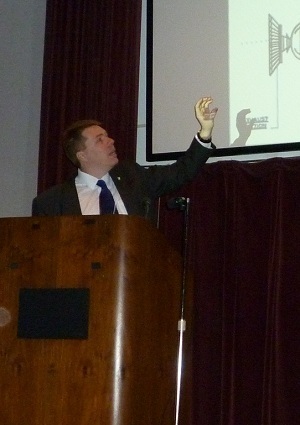
But Long paused only briefly on Alcubierre. His intent was to offer an overview of interstellar concepts, and in doing so he ran through the contribution made by the BIS not only with an early Moon mission design but also through Project Daedalus, the fusion starship that came out of late-night sessions in various London pubs back in the 1970s (particularly the Mason’s Arms, I’m told — is it still there?). At the party before the conference, Kelvin talked to me about his view that interstellar studies really began with Les Shepard’s 1952 paper “Interstellar Flight” (JBIS, Vol. 11, pp. 149-167). I think it’s a reasonable assumption, because Shepard’s was the first paper I know of to approach the question with true scientific rigor.
In fact, Shepard did a little worldship building of his own, as I noted in an obituary of the man written about a year ago. I’ll run the same quote I did then to make the point:
It is obvious that a vehicle carrying a colony of men to a new system should be a veritable Noah’s Ark. Many other creatures besides man might be needed to colonize the other world. Similarly, a wide range of flora would need to be carried. A very careful control of population would be required, particularly in view of the large number of generations involved. This would apply alike to humankind and all creatures transported. Life would go on in the vehicle in a closed cycle, it would be a completely self-contained world. For this and many other obvious reasons the vehicle would assume huge proportions: it would, in fact, be a very small planetoid, weighing perhaps a million tons excluding the dead weight of propellants and fuel. Even this would be pitifully small, but clever design might make it a sufficiently varied world to make living bearable.
But the paper goes on to look at antimatter options that could take starships up to relativistic speeds and considers not only time dilation but also the problems of running into stray gas and dust along the way. It’s a classic that’s well worth re-reading today. And it’s worth remembering that the JBIS ‘red cover’ issues devoted to interstellar studies set the standard for innovative thinking on the topic for many years. Although the British Interplanetary Society has run into a host of problems in the past few years, it’s heartening to see how much Kelvin has achieved as the new editor of JBIS in getting the publication back on schedule. Well done, sir.
I won’t go through all the interstellar propulsion concepts that Long and Obousy presented because they’re already part of our continuing discussion in these pages. Instead, I’ve asked both for a Centauri Dreams contribution, Obousy to talk about where Icarus Interstellar now stands and Long to give us more about JBIS and its history, including the fascinating fact that Project Daedalus came about largely to make a point about the Fermi paradox. Calling Daedalus ‘a balance between being credible and being bold,’ Long noted that even the most improbable starship design — if it could be shown to be feasible for future engineering — would have ramifications for Fermi’s ‘where are they’? question.
More on this in coming days, along with a series of stories on a space power concept that would constitute an essential early step in our building of a system-wide infrastructure. I’m also hoping to discuss an idea that is making a comeback, the colony starships of Robert Enzmann. Consolidating ideas from the Huntsville conference should keep me busy for quite some time.






February 11, 2013
The Long Result
I conceived an early love for Tennyson, but it wasn’t until a bit later in life that I ran into his “Locksley Hall,” which contains lines many science fiction fans are familiar with:
Many a night I saw the Pleiads, rising thro’ the mellow shade,
Glitter like a swarm of fire-flies tangled in a silver braid.
Here about the beach I wander’d, nourishing a youth sublime
With the fairy tales of science, and the long result of Time;
When the centuries behind me like a fruitful land reposed;
When I clung to all the present for the promise that it closed:
When I dipt into the future far as human eye could see;
Saw the Vision of the world and all the wonder that would be.—
and so on. The poem is the lament of a soldier returning to the places of his boyhood and eventually turning his thoughts, and his resolve, on the future. When I read the line ‘the long result of time,’ I realized that it was here that I found resonance with the poet. The idea of a remote futurity and the need to build its foundations now was a powerful motivator.
Building Structures That Last
A sense of that futurity pervaded our recent sessions at the Tennessee Valley Interstellar Workshop in Huntsville. Several speakers alluded to instances in human history where people looked well beyond their own generation, a natural thought for a conference discussing technologies that might take decades if not centuries to achieve. We talked about a solar power project that might take 35 years, or perhaps 50 (much more about this in coming days).

The theme became explicit when educator and blogger Mike Mongo talked about getting interstellar issues across to the public, referring to vast projects like the pyramids and the great cathedrals of Europe. Cathedrals are a fascinating study in their own right, and it’s worth pausing on them as we ponder long-term notions. Although they’re often considered classic instances of people building for a remote future, some cathedrals were built surprisingly quickly. Anyone who has stood in awe at the magnificent lines of Chartres southwest of Paris is surprised to learn that it came together in less than 60 years (the main structure in a scant 26), though keep in mind that this was partly a reconstruction of an earlier structure that dated back to 1145.
Image: The great cathedral at Chartres.
With unstinting public support, such things could happen even with the engineering of the day, creating what historians now view as the high point of French Gothic art. Each cathedral, of course, tells its own tale. Salisbury Cathedral was completed except for its spire in 45 years. Other cathedrals took longer. Notre Dame in Paris was the work of a century, as was Lincoln Cathedral, while the record for cathedral construction surely belongs to Cologne, where the foundation stone was laid in 1248. By the time of the Reformation 300 years later, the roof was still unfinished, and later turmoil pushed the completion of the cathedral all the way into the 19th Century, with many stops and starts along the way.
Remember, too, that the cathedral builders lived at a time when the average lifespan was in the 30s. The 15-year old boy who started working on the foundation of a cathedral might have hoped to see its consecration but he surely knew the odds didn’t favor it. Humans are remarkably good at this kind of thing, even if the frenetic pace and short-term focus of our times makes us forget it. Robert Kennedy pointed out to me at the conference that the Dutch dike system has been maintained for over 500 years, and can actually be traced back as far as the 9th Century. The idea of technology-building across generations is hardly something new to our civilization.
The ‘long result’ context is an interesting one in which to place our interstellar thinking. Naturally we’d like to make things happen faster than the 4000-year plus journeys I talked about on Friday with worldships, though my guess is that as the species becomes truly spacefaring and begins to differentiate, we’ll see colonies aboard O’Neill-class cylinders holding thousands, many of the colonists being people who will spend less and less time on a planetary surface. At some point, it would be entirely natural to see one of these groups decide to head into the interstellar deep. They would be, after all, taking their world with them, a world that was already home.
Evolutionary Change in Space
Gerald Driggers is a retired engineer and current science fiction author who worked with Gerald O’Neill in the 1970s. I see him as worldship material because he has chosen for the last seventeen years to live on a boat, saying “It was the closest thing I could get to a space ship.” Driggers believes we can begin our interstellar work by getting humans to Mars, where they will be faced with many of the challenges that will attend much longer-term missions. We must, after all, build a system-wide infrastructure, mastering the complexities of power generation and resource extraction on entirely new scales, before we can truly hope to go interstellar.
And what happens to humans as they begin working in extreme environments? Evolution doesn’t stop when we leave the planet, as Freeman Dyson is so fond of pointing out. These are changes that should be beneficial, says Driggers. “Evolutionary steps toward becoming interstellar voyagers reduce the chances for human failures on these journeys. We’re going to change, and we will continue to change as we look toward longer voyages. The first humans to arrive around another star system probably won’t be like anybody in the audience today.” Responding to evolutionary change, Martians may make the best designers and builders of interstellar craft.
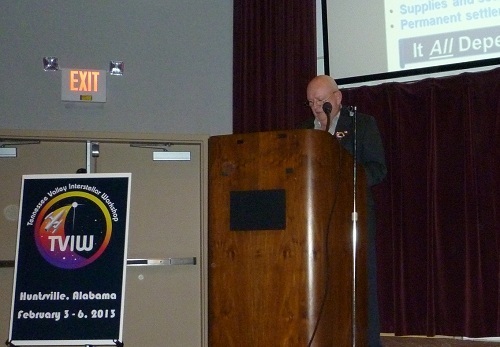
Image: Gerald Driggers discussing a near-term infrastructure that will one day support interstellar missions.
Get it right on Mars, in other words, and we get it right elsewhere and learn the basics of infrastructure building all the way to the Kuiper Belt, with active lunar settlements and plentiful activity among the asteroids. Along the way we adapt, we change. Driggers’ worst-case scenario has Martian settlements delayed until the mid-22nd Century, but he is hopeful that the date can be moved up and the infrastructure begun.
All of which brings me back to something Mike Mongo talked about. We are not going to the stars ourselves, but we can inspire and train people who will solve many of the technical problems going forward, just as they train the next generation. One of these generations will one day train the crew of the first human interstellar mission, or if we settle on robotics, the controllers who will manage our first probes. Placing ourselves in the context of the long result acknowledges our obligation to future generations as we begin putting foundation stones in place.






Paul Gilster's Blog
- Paul Gilster's profile
- 7 followers



